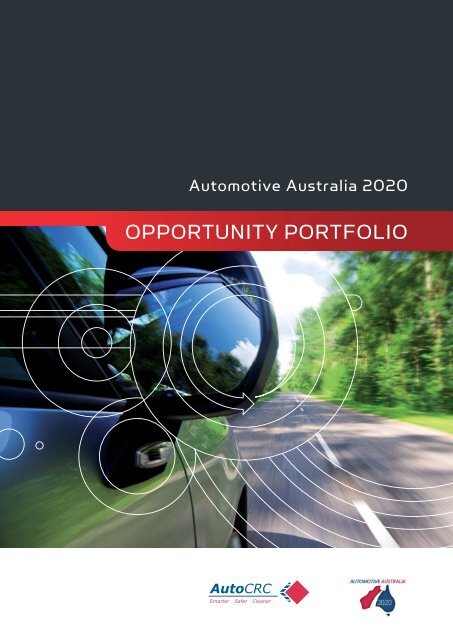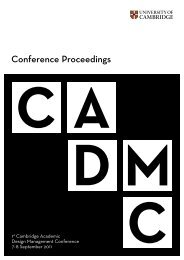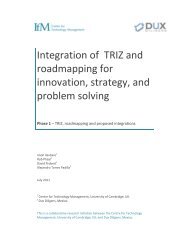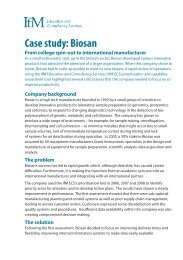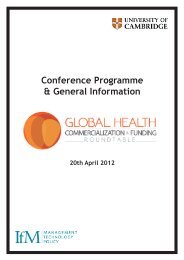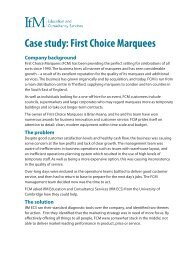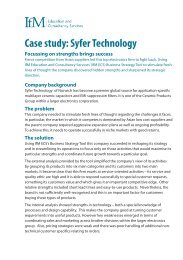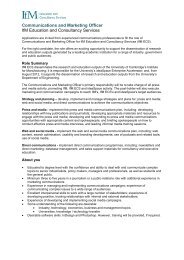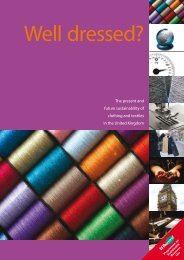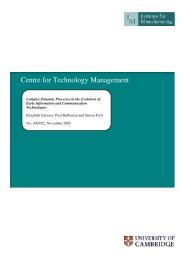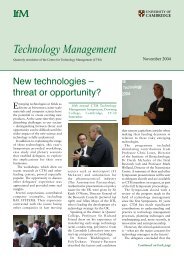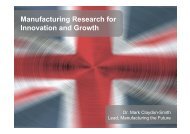Opportunity portfolio
Opportunity portfolio
Opportunity portfolio
Create successful ePaper yourself
Turn your PDF publications into a flip-book with our unique Google optimized e-Paper software.
Introduction 3<br />
Short Term Opportunities 4<br />
Long Term Opportunities 7<br />
<strong>Opportunity</strong> Area 1 Materials and Processes for Lightweighting 9<br />
<strong>Opportunity</strong> Area 2 Advanced Data and Communication Systems 11<br />
<strong>Opportunity</strong> Area 3 Vehicle Electrification 13<br />
<strong>Opportunity</strong> Area 4 Gaseous Fuel Driveline 17<br />
Next Steps 18<br />
Appendix 1 Workshop Participants 19<br />
Appendix 2 Evaluation Criteria 21<br />
1
The automotive industry is strategically important to the Australian economy in terms of the<br />
investment, jobs, skills, innovation and exports it generates. The future success of the Australian<br />
automotive industry will require it to expand on current strengths to exploit opportunities in the<br />
rapidly evolving global automotive market.<br />
Automotive Australia 2020 (AA2020)<br />
is a joint initiative of the<br />
Commonwealth Government’s<br />
New Car Plan for a Greener Future<br />
and Victorian Government’s VAMAP.<br />
This programme, led by the AutoCRC,<br />
is being undertaken with the<br />
Australian automotive industry to<br />
deliver a technology roadmap to 2020<br />
and beyond. This roadmap will be<br />
delivered to the Automotive Industry<br />
Innovation Council to communicate<br />
a vision and strategy to transform the<br />
automotive industry to be competitve,<br />
innovative and sustainable in the<br />
short, medium and long term.<br />
The global automotive industry<br />
is at a unique point of transition<br />
as it enters the second decade of<br />
the twenty-first century. After one<br />
hundred years of relatively stable,<br />
incremental evolution, the challenges<br />
of climate change and energy scarcity<br />
are forcing an unprecedented rate<br />
of technology change.<br />
The AA2020 Vision, developed in<br />
Phase 1 of the programme, sets<br />
out Australia’s ambition to use this<br />
upheaval to actively grow the local<br />
industry and to “…achieve recognition<br />
as a strategic element of the global<br />
automotive industry.” It also sets out<br />
a belief that “This can be achieved<br />
through leveraging existing strengths<br />
and building new capabilities.”<br />
Building on this vision, the Automotive<br />
Australia project has now completed<br />
Phase 4 with the presentation of<br />
this Opportunities Portfolio – the<br />
culmination of a three-month study<br />
into Technology Needs in local and<br />
global markets, and Australian<br />
Capability in the automotive,<br />
non-automotive and research<br />
sectors. The study has relied on<br />
extensive stakeholder engagement<br />
through surveys, interviews and<br />
workshops involving broad industry<br />
representation.<br />
As the project progresses into its final<br />
phases, it will focus on the key areas<br />
of opportunity identified in this report.<br />
The continued active engagement of<br />
industry will ensure the success of<br />
the process in providing a strategic<br />
direction to 2020 and beyond.<br />
Dr Matthew Doolan<br />
Project Manager<br />
Automotive Australia 2020<br />
Automotive Australia 2020 – <strong>Opportunity</strong> Portfolio 2
The Automotive Australia 2020 (AA2020) project aims to develop a roadmap for the Australian<br />
automotive industry looking to 2020 and beyond. This roadmap will represent a vision and strategy<br />
for the Australian automotive industry to remain competitive in the short, medium and long term.<br />
This report presents key strategic and<br />
tactical opportunities, the outcomes<br />
of the 4th phase of this project. This<br />
phase has been guided by the scope<br />
of opportunities and evaluation<br />
criteria set out in the first interim<br />
report (Automotive Australia 2020 –<br />
Vision), and is the extension of the<br />
data gathered through surveys and<br />
interviews in Phases 2 and 3.<br />
The data from Phase 2 and 3<br />
is available in the reports:<br />
Automotive Australia 2020 –<br />
Capabilities, and Automotive Australia<br />
2020 – Technology Needs. Together,<br />
these three reports present a<br />
snapshot of Australia’s current<br />
competitive position.<br />
Through a series of workshops,<br />
involving more than 80 representatives<br />
from government, automotive, nonautomotive<br />
and research sectors,<br />
needs and capabilities were assessed.<br />
This allowed identification of key short<br />
and long term opportunities. In the<br />
short term, three broad opportunity<br />
categories were identified:<br />
Immediate actions to grow or<br />
sustain local suppliers,<br />
Capabilities to be leveraged as<br />
export opportunities, and<br />
Activities designed to develop<br />
strategic capability in the long term.<br />
<br />
Establishing a vision<br />
<br />
Defining immediate domestic and long term future global technology need<br />
<br />
Understanding national capability<br />
<br />
Identifying key short and long term opportunities<br />
<br />
Strategic opportunity roadmap development<br />
<br />
Prioritisation<br />
Workshop assessment of long term<br />
opportunities identified four key areas<br />
of interest in the long term:<br />
Materials and Processes for<br />
Lightweighting,<br />
Gaseous Fuel Driveline Technology,<br />
Advanced Data and Communication<br />
Systems, and<br />
Vehicle Electrification.<br />
A detailed assessment has been<br />
made for each of the identified<br />
opportunities. This leads to Phase 5,<br />
where strategic opportunity roadmaps<br />
will be developed to further investigate<br />
the strongest of the long term<br />
opportunities. The aim of Phase 5 is<br />
to provide a detailed understanding<br />
of the specific opportunity, including<br />
the enabling actions that might be<br />
required to realise the opportunity.<br />
These strategic opportunity roadmaps<br />
will be prioritised during Phase 6 and<br />
become the final representation of the<br />
Automotive Australia 2020 roadmap,<br />
providing strategic direction for the<br />
Australian automotive industry to<br />
2020 and beyond.<br />
3
The identification of technology needs and capabilities has highlighted a number of potential<br />
opportunities in the short term. These were defined as opportunities for next model vehicles,<br />
or a 2012 timeframe and they have been validated and prioritised through the workshop process.<br />
Phases 2 and 3 of the project, described in the Technology<br />
Needs and Capabilities reports, identified more than 100<br />
short term opportunities for Australian suppliers to capture<br />
and maintain contracts with local MVPs, or to export into<br />
overseas markets. Initial research, through surveys and<br />
interviews, selected approximately 60 of these short term<br />
opportunities, which were assigned initial scores to rank<br />
the attractiveness of the opportunities and their fit with<br />
existing capability in the automotive industry. These were<br />
carried forward to a series of workshops. Through the<br />
workshop processes, these measures of capability and<br />
attractiveness were adjusted and validated by more than<br />
50 industry experts.<br />
To identify opportunities of interest, the attractiveness<br />
and fit with existing capability have been mapped to obtain<br />
an overall score as depicted in Figure 1. Through this<br />
process, 15 opportunities, including at least one from each<br />
of nine automotive subsystems, were selected for further<br />
validation at a Portfolio Workshop on November 27th, 2009.<br />
SHORT TERM OPPORTUNITIES BY ATTRACTIVENESS<br />
FIGURE 1 – SHORT TERM OPPORTUNITIES<br />
Automotive Australia 2020 – <strong>Opportunity</strong> Portfolio 4
The participants at the Portfolio Workshop were given<br />
the opportunity to adjust the overall attractiveness and<br />
capability score of the top 15 identified opportunities to<br />
establish the priority ranking shown in Table 1. In addition,<br />
the Portfolio Workshop identified three broad categories<br />
for short term opportunities:<br />
Immediate actions that might grow or sustain current<br />
local sourcing either by displacing imported components<br />
or protecting current local activities,<br />
Current capabilities that may be leveraged to generate<br />
a viable export activity (recognising that there will be<br />
significant lead time to achieve significant success), and<br />
Current activities that are important in building strategic<br />
capability in a technology area identified as being highly<br />
attractive in the long term.<br />
Using existing data, an analysis of the opportunities was<br />
carried out to highlight the three areas of opportunity<br />
identified above. Figure 2 plots the strength of local<br />
capability against a measure of the likely sourcing scenario.<br />
This measure was calculated based on the identified shift<br />
in future sourcing trends of the Australian MVPs, combined<br />
with a score representing the relative ease of import and<br />
export for each opportunity. This identifies several areas<br />
of strong Australian capability with potential to replace<br />
imported products.<br />
There are also opportunities to export commodities from<br />
Australia and, while this was a component of the overall<br />
attractiveness score calculated for each opportunity, it is<br />
informative to examine the data for export opportunities<br />
in isolation. Figure 3 represents the most attractive export<br />
opportunities for the Australian automotive industry.<br />
Finally, there are a number of identified short term<br />
opportunities that have a direct influence on future<br />
capability required to realise the long term opportunities<br />
presented in the following section. Opportunities to exploit<br />
raw material, for example steel and aluminium, cannot be<br />
realised in the short term. Although there are abundant<br />
natural resources, establishment of indigenous industrial<br />
capability will have a significant lead-time. Investment in<br />
the short term, however, will be critical if opportunities<br />
in lightweight metals and processing are to be realised.<br />
Similarly, IC engine and driveline technology development<br />
will have little short term impact, but would be instrumental<br />
in an emerging capability for design and development of<br />
gaseous fuel driveline technology.<br />
SHORT TERM OPPORTUNITIES BY SOURCING SCENARIO<br />
FIGURE 2 – POTENTIAL SOURCING SCENARIO AND AUSTRALIAN CAPABILITY FOR SHORT TERM OPPORTUNITIES<br />
5
Rank<br />
<strong>Opportunity</strong><br />
1 Aluminium<br />
2 Seat Set<br />
3 Painting Process<br />
4 Instrument Panel<br />
5 Aluminium Cylinder Head<br />
6 Suspension Springs<br />
7 Steel (Raw Material)<br />
8 Pressings<br />
9 IC Engine and Driveline Technology<br />
10 Rotors<br />
11 Radiator<br />
12 Combi Meter and Clock<br />
13 ABS/ESC<br />
14 Steering Wheel<br />
15 Auto-Shifter<br />
TABLE 1 – RANKED SHORT TERM OPPORTUNITIES<br />
SHORT TERM EXPORT OPPORTUNITIES<br />
FIGURE 3 – CAPABILITY AND EXPORT ATTRACTIVENESS OF SHORT TERM OPPORTUNITIES<br />
Automotive Australia 2020 – <strong>Opportunity</strong> Portfolio 6
Phase 4 of AA2020 used the vision and evaluation criteria from Phase 1 to identify opportunities<br />
where the Australian automotive industry has the potential to establish itself as a strategic world<br />
player. The needs and capabilities of over 50 technology opportunities have been used in a <strong>portfolio</strong><br />
analysis to prioritise sixteen of the most promising technology areas.<br />
There are two aspects to this analysis. The first step is to<br />
identify those technologies that will play a leading role in<br />
delivering the vehicles demanded by consumers in 2020<br />
and beyond. The second step is to understand Australian<br />
capabilities and resources that can be applied to these<br />
promising technologies. The combination of these two<br />
factors, shown in Figure 4, allows the selection of areas<br />
where attractive global market needs match well with<br />
Australia’s capability to deliver them, providing a basis<br />
to establish a sustainable and differentiated competitive<br />
position on the world stage.<br />
Underpinning this assessment are the findings in the<br />
report Automotive Australia 2020 – Technology Needs.<br />
The report highlights the most attractive global technology<br />
needs based on the analysis of over fifty published reports<br />
and roadmaps and the input of over 100 industry experts<br />
through interviews, surveys and workshops. Prioritisation<br />
of the identified needs was carried out according to the<br />
selection criteria established in Phase 1. The criteria<br />
address factors such as market size, accessibility and<br />
technical feasibility. These criteria are presented in detail<br />
in Appendix 2.<br />
LONG TERM OPPORTUNITIES<br />
FIGURE 4 – LONG TERM OPPORTUNITIES<br />
7
Identifying capabilities and resources that can<br />
be harnessed to address these needs requires an<br />
understanding of capability beyond the current Australian<br />
automotive supply base. While these form an essential<br />
foundation, it is important to understand the direction of<br />
technology and capacity for investment in the sector and<br />
its ability to innovate and exploit these investments within<br />
the industry. It is also vital to look beyond the confines<br />
of the automotive sector. Other industries have relevant<br />
technologies that are further advanced in their adoption,<br />
while the research sector has promising technologies in<br />
development. These external capabilities can be leveraged<br />
in meeting the future needs of the automotive industry.<br />
Each of these aspects of capability have been evaluated<br />
in the Automotive Australia 2020 – Capabilities report along<br />
with relevant links to Australia’s natural and human<br />
resources to evaluate a measure of long term capability<br />
relevant to each of the most attractive opportunities.<br />
The top 16 technologies, with borderline selections<br />
made through open discussion in the workshop, were<br />
then reviewed in more detail and a concise business case<br />
developed. These business cases include which Australian<br />
capabilities would enable delivery and what enabling<br />
actions might support success. As a final validation step,<br />
the priority technology opportunities were reviewed by the<br />
original members of the Vision Workshop and moderated<br />
to ensure consistency. These moderated scores resulted<br />
in the following prioritised list of long term opportunities<br />
in Table 2.<br />
The technologies that emerged as priorities through<br />
this analysis fall into four themes. Each of these is<br />
an integral part of achieving the industry vision to<br />
“maximise opportunities in local and international markets”.<br />
These were:<br />
Materials and Processes for Lightweighting:<br />
– Design for reduced vehicle weight,<br />
– Materials and Processes for light-weight<br />
composites and plastics,<br />
– Materials and Processes for light-weight metals, and<br />
Rank<br />
<strong>Opportunity</strong><br />
1 Light Weight Vehicle Bodies<br />
2 Design for Reduced Vehicle Weight<br />
3 Materials and Processes for<br />
Lightweight Metals<br />
4 LPG and CNG<br />
5 Vehicle Recharging<br />
6 Electric Vehicle Power and Drivetrain<br />
7 Materials and Processes<br />
for Composites and Plastics<br />
8 Electric Motors<br />
9 Supercapacitors<br />
10 On-Vehicle Gaseous Fuel Storage<br />
11 Advanced Batteries<br />
12 Wireless V2V and V2I Communications<br />
13 Driver Information<br />
14 High Speed Data Buses<br />
15 Energy Absorbing Structures<br />
– Reduced weight vehicle bodies.<br />
Advanced Data and Communications Systems:<br />
– V2V and V2I Wireless Communications,<br />
– Driver Information Systems, and<br />
– High Speed Data Buses.<br />
Vehicle Electrification:<br />
– EV Power and Drivetrain,<br />
– Electric Motors,<br />
– Advanced Batteries,<br />
– Supercapacitors, and<br />
– Vehicle Recharging.<br />
Gaseous Fuel Driveline:<br />
– LPG & CNG Engines, and<br />
– On-vehicle storage of gaseous fuels.<br />
The attractiveness of these technology opportunities is<br />
determined by external, global factors beyond the influence<br />
of Australian stakeholders. However, the current Australian<br />
capability can clearly be developed and advanced further<br />
through focused intervention in areas of the most attractive<br />
opportunity. These will be carried forward to the final<br />
phases of the project.<br />
16 Improved CFD and FEA<br />
TABLE 2 – RANKED LONG TERM OPPORTUNITIES<br />
Automotive Australia 2020 – <strong>Opportunity</strong> Portfolio 8
Four opportunities were identified in the area of Materials and Processes for Lightweighting. These<br />
opportunities are Design for Reduced Vehicle Weight, Reduced Weight Vehicle Bodies, Materials<br />
and Processes for Composites and Plastics and Materials and Processes for Light Weight Metals.<br />
To improve the fuel efficiency and reduce emissions from vehicles manufacturers continue to reduce vehicle weight.<br />
Current trends include the use of high strength steels, to reduce the thickness of components, and material substitution<br />
with lighter weight alternatives. These trends will continue subject to the cost effectiveness of mass reduction.<br />
Design for Reduced Vehicle Weight<br />
This opportunity is an engineering service and an enabler<br />
for meeting the market need for light weight vehicles.<br />
Design for Reduced Vehicle Weight encompasses<br />
designing with new materials and new approaches<br />
with vehicle design.<br />
Across all the measurements of attractiveness this<br />
opportunity has scored very highly. The size of both the<br />
local and global markets indicates the global application<br />
of the capability. Design for Reduced Vehicle Weight<br />
encompasses all components of the vehicle. The<br />
breadth of this application has led to its identification<br />
as an opportunity for Australia to play a leadership role.<br />
The social, economic and environmental attractiveness<br />
of this opportunity has again been identified as high.<br />
This is due to the high value add nature of design<br />
and the reduction in emissions achieved through the<br />
reduction of vehicle weight.<br />
Australian capabilities have been identified as strong in the<br />
area of weight reduction. The focus of MVPs to reduce the<br />
vehicle weight has meant that the automotive supply base<br />
has been developing and focusing on methods to reduce<br />
the weight of their products. This has resulted in both<br />
current and developing industry capability in the area<br />
of design for reduced vehicle weight.<br />
There is also significant identification of alignment with the<br />
non-automotive sector, which may include industries such<br />
as aerospace. The identified alignment with natural and<br />
human resources reflects the current level of engineering<br />
design capability present in Australia.<br />
Materials and Processes for Composites and Plastics<br />
To reduce the weight of vehicles, the use of new<br />
materials is becoming increasingly common. Two<br />
classes of materials have started to replace heavier<br />
traditional materials – plastics and composite materials.<br />
The opportunity Materials and Processes for Composites<br />
and Plastics, involves the development of new composite<br />
and plastic materials, and the associated manufacturing<br />
processes.<br />
The attractiveness of the opportunity is strong against all<br />
the assessment criteria. The opportunity for leadership<br />
in this area is indicated as very strong. This may be due<br />
to the strong capability identified in the non-automotive<br />
sector. Advanced plastic and composite materials are<br />
used extensively in the aerospace and defence industries.<br />
Difficulty in recycling these materials at End-of-Life<br />
remains a problem.<br />
FIGURE 5 – ATTRACTIVENESS AND CAPABILITY SCORES<br />
FOR DESIGN FOR REDUCED VEHICLE WEIGHT<br />
FIGURE 6 – ATTRACTIVENESS AND CAPABILITY SCORES<br />
FOR PLASTICS AND COMPOSITES<br />
9
Materials and Processes for Lightweight Metals<br />
Like the previous opportunity, materials and processes<br />
for lightweight metals focuses on the reduction of vehicle<br />
weight. Materials that fall into this category include<br />
aluminium and magnesium alloys.<br />
This opportunity is seen as the most attractive in the<br />
area of lightweight material. This is due to the size of the<br />
market for lightweight metals both locally and globally.<br />
The technical feasibility of this opportunity is seen as very<br />
high as there is already some use of these materials in<br />
vehicles. The use of these materials is growing, with scope<br />
to solve problems associated with joining and interaction<br />
of different metals.<br />
The Australian capability associated with the lightweight<br />
metals opportunities shows significant alignment with the<br />
research sector, in contrast to the plastics and composite<br />
materials opportunity. In contrast to composite materials,<br />
lightweight metals are cost effective to recycle.<br />
Reduced Weight Vehicle Bodies<br />
This opportunity is the resulting output of the three previous<br />
opportunities. The manufacture of Reduced Weight Vehicle<br />
Bodies can be achieved by applying advances in plastics,<br />
composites and light metals combined with design for<br />
weight reduction. Vehicle bodies are particularly suited to<br />
weight reduction because gains can be achieved without<br />
sacrificing safety or performance.<br />
The size of the market for lightweight vehicle bodies<br />
has been identified as very large both globally and<br />
locally. The attractiveness of the opportunity is further<br />
enhanced by its technical feasibility. However, the<br />
opportunity for leadership in this area, and social,<br />
economic and environmental factors have been<br />
identified as less attractive.<br />
The capability of the automotive industry and research<br />
community in this area is considered very strong. The<br />
lack of alignment with the non-automotive sector is not<br />
surprising as most components in the body of a car are<br />
not transferable from the non-automotive sector. Any<br />
alignment with non-automotive sectors is in the area of<br />
design and materials as identified in the three previous<br />
opportunities.<br />
FIGURE 7 – ATTRACTIVENESS AND CAPABILITY SCORES<br />
FOR LIGHTWEIGHT METALS<br />
FIGURE 8 – ATTRACTIVENESS AND CAPABILITY SCORES<br />
FOR REDUCED WEIGHT VEHICLE BODIES<br />
Automotive Australia 2020 – <strong>Opportunity</strong> Portfolio 10
In Phase 1 of the AA2020 project, participants in the Vision Workshop also identified advances<br />
in ICT technology as a key driver, with comfort, integration, convenience and flexibility as related<br />
customer requirements. Three specific opportunities of interest have been identified in this area:<br />
Wireless Communications, Driver Information and High Speed Data Buses.<br />
Developments in software, electronics and communications represent the largest area of technology development in the<br />
automotive industry and are a key element for more than 80% of new automotive technology 1 . This trend is an important<br />
element of the current transition toward an increasingly knowledge-based economy.<br />
Wireless V2V and V2I Communications<br />
There is increasing consumer demand for data connectivity<br />
in all facets of life, and vehicle communications are no<br />
exception. Vehicle communications fall into two categories:<br />
communication between vehicles (V2V) and communication<br />
with infrastructure (V2I). Because these technologies are<br />
a natural extension of current consumer technologies, the<br />
Australian market, global market, and technical feasibility<br />
all rate highly. The social and economic benefit associated<br />
with continuous connectivity also scored highly in Figure 9.<br />
The power of V2V and V2I communications extends<br />
beyond the exchange of information between drivers and<br />
passengers. By implementing more advanced telematics<br />
features, road safety could be increased and congestion<br />
reduced. Reduced congestion and travel times have a<br />
significant social and environmental benefit.<br />
Current capability in communication systems has been<br />
identified in Australia, especially in the non-automotive<br />
sector. This opportunity does not take advantage of natural<br />
resources, and there is a medium score for alignment with<br />
research capability, which will be investigated further in<br />
Phase 5.<br />
Driver Information<br />
With the advanced communications described above,<br />
useful information can be extracted and presented to<br />
the driver to increase both safety and comfort. As traffic<br />
congestion increases, driver information systems will<br />
provide a real social and economic benefit – reducing<br />
travel time. Consequently, the social, economic and<br />
environmental benefit has achieved the highest score in<br />
Figure 10. This opportunity rates highly in other criteria<br />
as well. Capability has been identified in current suppliers<br />
of underlying technologies, like sensors and software.<br />
The universal applicability of many of these technologies<br />
indicates possibilities for integration with other sectors,<br />
which is reflected in the alignment with research and<br />
non-automotive capability. The size of the local and global<br />
market indicates that driver information systems will be<br />
available in a large number of vehicles, but not universally.<br />
FIGURE 9 – ATTRACTIVENESS AND CAPABILITY SCORES<br />
FOR WIRELESS V2V AND V2I COMMUNICATIONS<br />
FIGURE 10 – ATTRACTIVENESS AND CAPABILITY SCORES<br />
FOR DRIVER INFORMATION<br />
1 Supplier Business. The Automotive Technology Roadmap. 2009.<br />
11
High Speed Data Buses<br />
As advanced data communications systems gain<br />
importance, so do high speed data buses – the underlying<br />
systems that enable most of the advances in automotive<br />
ICT technology. The universal nature of these systems<br />
is represented by high overall scores for market size as<br />
shown in Figure 11.<br />
Through the workshop, Australia was identified as<br />
having strong capability and engineering knowledge in<br />
microprocessor design and communications technology.<br />
While not currently applied to high speed data buses,<br />
there are resulting high scores in future capability and<br />
alignment with the non-automotive sector. Secondary<br />
social and economic drivers also present a compelling<br />
case. The technologies enabled by high speed data buses<br />
have already been shown to have an impact on improving<br />
safety and comfort. There are also potential gains in<br />
weight reduction from wiring harnesses, reducing weight<br />
and cost of manufacturing. The combination of these<br />
factors will make high speed data buses a part of every<br />
car manufactured in 2020.<br />
FIGURE 11 – ATTRACTIVENESS AND CAPABILITY SCORES<br />
FOR HIGH SPEED DATA BUSES<br />
Automotive Australia 2020 – <strong>Opportunity</strong> Portfolio 12
The Vehicle Electrification category encompasses nearly one third of the priority opportunities<br />
that have been identified:<br />
Electric Vehicle Power and Drivetrain,<br />
Cost Effective, High Efficiency Electric Motors,<br />
Advanced Battery Technology,<br />
Supercapacitors, and<br />
Vehicle Recharging.<br />
High attractiveness and future capability scores across these opportunities are highly compatible<br />
with the trends, drivers and vision identified in the first phase of the project. Participants in the Vision<br />
Workshop identified increasing consumer awareness of environmental issues and developments<br />
in energy storage technology as important drivers, articulating an ambition for Australia to be<br />
“leading designers of competitive, large, powerful, zero emission passenger vehicles.”<br />
Potential environmental and social benefits associated with the widespread adoption of electric vehicles are immense.<br />
Social benefits might include factors like reduced traffic noise, fewer maintenance requirements, and reduction of smog<br />
and pollutants in urban environments. Environmental benefits stem from increased efficiency and elimination of tailpipe<br />
emissions. A recent well-to-wheel analysis of alternative vehicle technology estimated the net CO 2<br />
emissions of an electric<br />
vehicle at 115g/km versus 127g/km for diesel vehicles and 252g/km for modern petrol vehicles, 2 where CO 2<br />
emissions from<br />
electric vehicles are the result of electricity generation. It is this potential for the system as a whole that has been reflected<br />
in the relevant attractiveness scores.<br />
There are also predicted economic benefits. Though the purchase price is higher, running costs of electric vehicles are<br />
already lower than the equivalent IC engine vehicle and it is predicted that total cost of ownership for mass produced<br />
electric vehicles will also be lower. 3<br />
Electric Vehicle Power and Drivetrain<br />
The changes required in the vehicle drive system of an<br />
electric vehicle extend beyond the core power plant<br />
and these auxiliary systems have been termed Electric<br />
Vehicle Drivetrain. This opportunity includes all of the<br />
power handling and drive system components beyond<br />
the electric motor. The drivetrain will include such<br />
subsystems as:<br />
Power control,<br />
Electrical distribution,<br />
Gearing, and<br />
Regenerative braking.<br />
In the same manner as electric motors, the other<br />
drivetrain subsystems are components of existing<br />
hybrid vehicles and, as such, represent an existing,<br />
growing market in Australia and internationally.<br />
FIGURE 13 – ATTRACTIVENESS AND CAPABILITY SCORES<br />
FOR EV POWER AND DRIVETRAIN<br />
2 MA Komer, JB Heywood. Electric Powertrains: Opportunities and Challenges in the US Light-Duty Vehicle Fleet. Sloan Automotive Laboratory, MIT. May 2007.<br />
3 US Department of Energy. Electric and Hybrid Vehicle Research, Development, and Demonstration Program; Petroleum-Equivalent Fuel Economy Calculation. June, 2000.<br />
13
Cost Effective, High Efficiency Electric Motors<br />
Changing from conventional internal combustion engines<br />
to electric motors is the most fundamental shift required<br />
in realising this opportunity. Sales of hybrid vehicles, each<br />
with at least one electric motor, are increasing steadily<br />
and increased adoption of electric only vehicles would only<br />
increase the size of this market in Australia and overseas.<br />
Electric motor technology, which is already widespread<br />
outside of the automotive industry, is well advanced and this<br />
is demonstrated by the relatively high scores for technical<br />
feasibility and alignment with current capability shown in<br />
Figure 12.<br />
Australia currently boasts capability for design,<br />
development and manufacturing of large electric<br />
motors, similar to those that would be used in OEM<br />
vehicle production, and this is reflected in the capability<br />
scoring. There are also strong linkages with current<br />
research activities and manufacturing capability in the<br />
automotive sector.<br />
The efficiency of electric motors is already very high,<br />
so improvements in overall electric vehicle efficiency<br />
will be driven by other parts of the drive system. Future<br />
developments in motor technology will most likely relate<br />
to reducing the cost of production, coupled with reduced<br />
size and weight. Australia can leverage existing design<br />
expertise and complimentary manufacturing capability<br />
with natural reserves of rare earth metals to build a<br />
significant local industry.<br />
FIGURE 12 – ATTRACTIVENESS AND CAPABILITY SCORES<br />
FOR ELECTRIC MOTORS<br />
Automotive Australia 2020 – <strong>Opportunity</strong> Portfolio 14
Advanced Battery Technology<br />
When compared with current internal combustion<br />
drivetrain technology, electric vehicles are disadvantaged<br />
in a number of key areas: range, convenience of recharging,<br />
size and weight of energy storage systems. Consequently,<br />
a major focus of current research in the electric vehicle<br />
sector is energy storage technology, which includes<br />
developments in batteries (described here) and other<br />
methods (like supercapacitors, described in the<br />
following subsection).<br />
Much of the new development in this sector has been<br />
forecast to take advantage of a variety of lithium battery<br />
chemistries with significant expansion in the lithium<br />
battery market expected in the medium term. It has been<br />
estimated that lithium-ion batteries in some form will be<br />
the technology of choice for vehicle producers and that the<br />
global market for electric vehicle batteries will increase<br />
from $878 million in 2010 to $8 billion by 2015. 4<br />
In the next 20 years, it has been estimated that battery<br />
technology will be required that achieves an energy storage<br />
density of more than 400Wh/kg, with a cost less than<br />
$200/kWh 5 . This performance leap from currently available<br />
batteries has huge global potential as indicated by strong<br />
scores for Australian and global market size in Figure 14.<br />
Current Australian capability in this sector is limited, but<br />
research in the field and transferable capability from<br />
outside the automotive industry indicate that there is high<br />
potential to develop future capability in advanced batteries.<br />
Difficulty in accessing global technology, however, suggests<br />
that a competitive local industry will have to develop<br />
indigenously. This could be aided by a knowledge base with<br />
strong research and development skills and by leveraging<br />
Australia’s rich endowment of related raw materials.<br />
The factors that increase the attractiveness of battery<br />
technology development are equally enticing to other global<br />
markets. Billions of dollars are currently being invested by<br />
international governments and multinational corporations.<br />
This limits Australia’s opportunity to establish a leadership<br />
position, and makes access to internationally developed<br />
technology more difficult, as reflected in the relevant scores.<br />
Supercapacitors<br />
Electric double-layer capacitors, otherwise known<br />
as supercapacitors or ultracapacitors, are a possible<br />
competitive, or complementary, solution for energy storage<br />
in electric vehicles. The underlying effect has been known<br />
since 1957, but the market for commercial applications<br />
has only been active in the last decade, reaching<br />
$208 million in 2008. It is estimated that the market<br />
will exceed $870 million by 2014. 6 Supercapacitors have<br />
a number of advantages over chemical battery technology:<br />
Much faster charge and discharge rates,<br />
Long lifecycles, and<br />
Low toxicity of constituent materials.<br />
The attractiveness scores presented in Figure 15 show<br />
a particularly high score for leadership opportunity and<br />
this reflects current design and development capability in<br />
Australia. This is further demonstrated by high scores for<br />
alignment with Australian capability scores in all sectors.<br />
Local research and development has led to a global<br />
strength in this area.<br />
Supercapacitors will most likely be applied to electric<br />
vehicles in three ways: as a storage solution for high<br />
power loads associated with regenerative braking and<br />
acceleration, to provide high current bursts to intermittent<br />
systems like solenoids, and in a hybrid configuration<br />
to increase the performance of battery energy storage.<br />
Should the adoption of electric vehicle technology proceed<br />
according to current expectations, supercapacitors will play<br />
an important role.<br />
FIGURE 14 – ATTRACTIVENESS AND CAPABILITY SCORES<br />
FOR ADVANCED BATTERIES<br />
FIGURE 15 – ATTRACTIVENESS AND CAPABILITY SCORES<br />
FOR SUPERCAPACITORS<br />
4 Pike Research. Electric Vehicle Batteries. December, 2009.<br />
5 New Automotive Innovation and Growth Team. An Independent Report on the Automotive Industry in the UK. May 2009.<br />
6 Lux Research. Bridging the Gap with Supercapacitors: A Tale of Two Markets. June 2009.<br />
15
Vehicle Recharging<br />
One major hurdle for the mass market acceptance of<br />
electric vehicles is convenience of recharging. This includes<br />
both on-vehicle solutions to simplify the recharging<br />
process, and the development of infrastructure for<br />
convenience and speed of recharging away from home.<br />
The capability factors in Figure 16 show particularly strong<br />
links related to the deployment of infrastructure for vehicle<br />
recharging. Australia has high availability of electricity<br />
infrastructure suitable for vehicle charging as reflected<br />
by the fit with resources score. This score also relates<br />
to a natural wealth in future clean energy resources<br />
like solar and wind. The alignment with current and<br />
future capability is particularly high owing to long<br />
experience in the design and production of electrical<br />
products. The process has identified comparatively little<br />
relevant capability in the research sector and, this will<br />
be investigated further in Phase 5.<br />
Attractiveness factors are also quite high, with the notable<br />
exception of the global market, as the unique challenges<br />
in other markets indicate comparatively little possibility of<br />
exporting infrastructure systems. The Australian market,<br />
however, is seen as a classic early adopter nation and<br />
would readily serve as a test case. As a prime requirement<br />
for the widespread adoption of electric vehicles, recharging<br />
systems and infrastructure will contribute directly to any<br />
social, economic or environmental benefits that are to<br />
be realised.<br />
FIGURE 16 – ATTRACTIVENESS AND CAPABILITY SCORES<br />
FOR VEHICLE RECHARGING<br />
Automotive Australia 2020 – <strong>Opportunity</strong> Portfolio 16
Two long term opportunities were identified in the area of gaseous fuels: LPG and CNG; and Storage<br />
of Gaseous Fuels. Both these opportunities were identified in the Automotive Australia 2020 – Vision<br />
report as being relevant in the medium to long term. These opportunities are part of a wider trend<br />
towards alternative internal combustion fuels and build on the short term opportunity of IC engine<br />
and driveline technology.<br />
Australia is a net exporter of natural gas 7 and LPG 8 , with significant reserves of both. There is significant national capability<br />
in extraction, refining, distribution, and storage of gas. This capability and resource strength is closely aligned with the<br />
identified opportunity in gaseous fuels.<br />
LPG and CNG<br />
The LPG and CNG opportunity describes the use of<br />
gaseous fuel as an alternative fuel for internal combustion<br />
engines. This opportunity includes the development of<br />
complete gaseous fuel systems. While LPG is currently<br />
available in the Australian market as an alternative fuel for<br />
passenger vehicles, CNG has only limited availability. LPG<br />
and CNG fitment to vehicles is available in the automotive<br />
aftermarket industry. LPG is also available as an Original<br />
Equipment Manufacturer (OEM) option on some Australian<br />
manufactured vehicles.<br />
As shown in Figure 17, the process has identified a<br />
significant accessible market size both globally and locally.<br />
Social, economic and environmental benefits have also<br />
been identified. The social and economic benefit is linked<br />
to the ability to source the components and gas from<br />
Australian industry, while the environmental benefits of<br />
LPG and CNG are realised in a reduction in greenhouse<br />
gas emissions 2 .<br />
Currently, there is engine and fuelling system technology<br />
available for the use of LPG and CNG fuels as indicated by<br />
the high technical feasibility of the opportunity. However,<br />
there are still technical challenges to encourage greater<br />
consumer acceptance of the technology. The LPG and CNG<br />
opportunity links well with the current automotive sector<br />
capabilities, with many of the components already available<br />
through the current supply base. It rates most highly in fit<br />
with human and natural resources, taking direct advantage<br />
of Australian gas reserves.<br />
Storage for Gaseous Fuels<br />
The opportunity for storage of gaseous fuels describes<br />
the development and manufacture of vehicle gaseous fuel<br />
storage tanks. This is directly aligned with the opportunity<br />
for LNG and CNG fuel systems for vehicles. Currently,<br />
the storage of gaseous fuels for a vehicle, fitted either<br />
as OEM equipment or aftermarket, involves the use of<br />
a large, heavy tank. These tanks can be sourced from the<br />
local manufacturing industry. The long term opportunity<br />
identifies innovation in storage tanks to reduce weight<br />
and improve geometry to suit vehicle integration.<br />
The attractiveness of this opportunity, as indicated by<br />
market size in Figure 18, is similar to that of the LPG and<br />
CNG opportunity. Difficulties associated with shipping fuel<br />
tanks limit market access, which results in a lower score<br />
for global accessible market.<br />
The capabilities that have been identified with this<br />
opportunity again show a good alignment with current<br />
and future industry capability. Scores in alignment<br />
with research capability and alignment with the nonautomotive<br />
sector are notable weaknesses for this<br />
opportunity. This perceived weakness will be investigated<br />
further in Phase 5 of the project.<br />
FIGURE 17 – ATTRACTIVENESS AND CAPABILITY SCORES<br />
FOR LPG AND CNG<br />
FIGURE 18 – ATTRACTIVENESS AND CAPABILITY SCORES<br />
FOR STORAGE FOR GASEOUS FUELS<br />
7 Australian Goverment, Austrade. Retrieved from http://www.austrade.gov.au/oil-gas-overview/default.aspx, viewed 16 Dec 2009.<br />
8 LPG Australia. Retrieved from http://www.lpgaustralia.com.au/index.php?option=com_content&view=article&id=50&itemid=55, viewed 16 Dec 2009.<br />
17
Phases 1 to 4 of the AA2020 roadmap have identified a number of priority opportunities to meet<br />
the AA2020 Vision, in both the short and long term. These have been refined, from a very extensive<br />
initial data capture, through a filtering process involving over 200 interview, survey and workshop<br />
participants. The short term opportunities will be taken forward to government and industry<br />
stakeholders to determine the future course of action.<br />
Prioritised long term opportunities will be explored<br />
further in Phase 5 of the programme, through a series<br />
of workshops covering the four broad themes of electric<br />
vehicles, light-weighting, gaseous fuels and driver<br />
information and communications. These will bring<br />
together subject-area experts in each of these themes,<br />
selected on the basis of their relevance to the shortlisted<br />
opportunities, and drawn from all stakeholder groups<br />
within the automotive sector, broader industry and<br />
academia and research. One of the primary objectives of<br />
the final phases of the project will be to identify enabling<br />
actions that support the four opportunity areas that have<br />
been taken forward. A preliminary list of enablers was<br />
identified by the workshop participants and these will<br />
be explored and expanded. These include:<br />
Technology transfer from other sectors,<br />
Product innovation,<br />
Leverage natural resources and energy,<br />
Industry collaboration through cluster development,<br />
International collaboration and export market exploration,<br />
Support for investment in capacity and infrastructure,<br />
Improve skills base and education,<br />
Standards,<br />
Incentives for consumer adoption of new technology, and<br />
Focussed R&D and commercialisation.<br />
Each workshop will build on the outputs of the first four<br />
phases to develop detailed roadmaps tailored to each<br />
opportunity area. These recommendations will then<br />
be reviewed in Phase 6 to prioritise investment and<br />
policy decisions. Together, these roadmaps will form<br />
an implementation plan; guiding the funding, policy,<br />
skills and technology development required to achieve<br />
the industry’s vision for 2020 and beyond.<br />
FIGURE 19 – THE AA2020 ROADMAP PROCESS<br />
Automotive Australia 2020 – <strong>Opportunity</strong> Portfolio 18
The data presented in this document and the accompanying reports (Automotive Australia<br />
2020 – Technology Needs, and Automotive Australia 2020 – Capabilities) was gathered through<br />
research before validation at a series of workshops in November, 2009. The participation of the<br />
following organisations and individuals was instrumental in establishing the preceding <strong>portfolio</strong><br />
of opportunities.<br />
Name<br />
Dr Michael Brear<br />
Ms Angela Krepcik<br />
Mr Peter Taylor<br />
Mr Linsey Siede<br />
Mr Hayden Williams<br />
Mr Stuart Charity<br />
Mr Russell Pettis<br />
Mr Richard Johns<br />
Mr Nixon Apple<br />
Dr Gary White<br />
Dr Matthew Cuthberston<br />
Dr Thomas Ting<br />
Mr Barry Comben<br />
Mr David Sykes<br />
Mr Ross McDonald<br />
Mr Evan Thornley<br />
Mr Talal Yassine<br />
Mr John Giuliani<br />
Mr Pierre Mars<br />
Mr George Collins<br />
Mr Masato Furumi<br />
Mr Steve Hermann<br />
Mr Brian Hughes<br />
Mr Hasib Felic<br />
Mr Danny Edmunds<br />
Mr Neil Silke<br />
Mr Wolfgang Obst<br />
Mr Barrie Finnin<br />
Mr Stan McGlashan<br />
Mr Guy Amedee<br />
Dr David Charles<br />
Mr Damon Cantwell<br />
Mr Todd Standal<br />
Mr Bryan Rickard<br />
Mr Gavan Keenan<br />
Mr Christopher Wong<br />
Mr John Conomos AO<br />
Mr Steve Payne<br />
Organisation<br />
ACART<br />
Advanced Manufacturing Australia<br />
ASEA<br />
ASEA<br />
Austrade<br />
Australian Automotive Aftermarket Association<br />
Australian Automotive Air Pty Ltd<br />
Australian Automotive Intelligence<br />
Australian Manufacturing Workers Union<br />
AutoCRC<br />
AutoCRC<br />
AutoCRC<br />
AutoCRC<br />
Backwell IXL<br />
Backwell IXL<br />
Better Place<br />
Better Place<br />
Bostik Australia Pty Ltd<br />
Cap-XX Pty Ltd<br />
CAST CRC<br />
Century Yuasa<br />
Century Yuasa<br />
CME<br />
CMG Technology Pty Ltd<br />
Continental Pty Ltd<br />
Continental Pty Ltd<br />
Continental Pty Ltd<br />
CSIRO<br />
DAIR<br />
Dana Automotive Systems Group Australia<br />
Deloitte Touche Tohmatsu<br />
Deloitte Touche Tohmatsu<br />
Deloitte Touche Tohmatsu<br />
Denso Australia Group<br />
Denso Australia Group<br />
Department of Innovation, Industry and Regional Development, Government of Victoria<br />
Automotive Industry Envoy, Australian Goverment<br />
Department of Innovation, Industry, Science and Research, Government of Australia<br />
TABLE 3 – WORKSHOP PARTICIPANTS<br />
19
Name<br />
Mr Richard Reilly<br />
Mr David Robb<br />
Mr Jonathan Holbrook<br />
Mr Peter De Leur<br />
Mr Peter Haynes<br />
Mr Sam Casabene<br />
Mr Brian Thiele<br />
Mr Ross Mahon<br />
Mr David Chuter<br />
Mr Graeme Lane<br />
Mr James Constable<br />
Mr Jaydeep Solanki<br />
Mr Jim Mandilas<br />
Mr Richard Marshall<br />
Mr Stuart Adams<br />
Mr Tim Newman<br />
Mr Peter Keley<br />
Mr Mark Phillips<br />
Mr Anthony Ibrahim<br />
Mr Steve Mellor<br />
Mr Mark Albert<br />
Prof. Stan Skafidas<br />
Mr David Worth<br />
Mr Terry Stinson<br />
Mr Tony Fitzgerald<br />
Mr Michael Sparrow<br />
Mr Winston Nel<br />
Mr Rohan Appleton<br />
Mr Andrew Hynson<br />
Prof. Aleks Subic<br />
Mr Gavin Smith<br />
Mr Graeme Wallace<br />
Mr Mike Shnier<br />
Mr Richard Farkashazy<br />
Mr Barry Budge<br />
Mr Cameron Cormack<br />
Mr David Jaksa<br />
Mr Lenny Tarollo<br />
Mr Mark Carbonari<br />
Mr Ronald Grasso<br />
Mr Mike Rausa<br />
Mr Mark Welte<br />
Mr Wayne Durrant<br />
Mr Juergen Bracht<br />
Organisation<br />
FAPM<br />
Ford Motor Company of Australia Limited<br />
Ford Motor Company of Australia Limited<br />
Ford Motor Company of Australia Limited<br />
Ford Motor Company of Australia Limited<br />
Ford Motor Company of Australia Limited<br />
Futuris Automotive Group Ltd<br />
Futuris Automotive Group Ltd<br />
Futuris Automotive Group Ltd<br />
GM Holden Limited<br />
GM Holden Limited<br />
GM Holden Limited<br />
GM Holden Limited<br />
GM Holden Limited<br />
GM Holden Limited<br />
GM Holden Limited<br />
GM Holden Limited<br />
Grant Thornton Australia Ltd<br />
KPMG<br />
Marand Precision Engineering Pty Ltd<br />
MTM Pty Ltd<br />
NICTA<br />
Orbital Corporation Limited<br />
Orbital Corporation Limited<br />
Orbital Corporation Limited<br />
PPG Industries Australia Pty Ltd<br />
PPG Industries Australia Pty Ltd<br />
Precision Plating (Aust.) Pty Ltd<br />
Prodrive Automotive Technology (Australia) Pty Ltd<br />
RMIT University<br />
Robert Bosch (Australia) Pty Ltd<br />
Simms Metal Management<br />
Tenneco Australia and New Zealand<br />
Thales Australia<br />
Toyota Motor Corporation Australia<br />
Toyota Motor Corporation Australia<br />
Toyota Motor Corporation Australia<br />
Toyota Motor Corporation Australia<br />
Toyota Motor Corporation Australia<br />
Toyota Motor Corporation Australia<br />
Toyota Motor Corporation Australia<br />
ZF Lemforder Australia<br />
ZF Lemforder Australia<br />
ZF Lemforder Australia<br />
TABLE 3 – WORKSHOP PARTICIPANTS CONTINUED<br />
Automotive Australia 2020 – <strong>Opportunity</strong> Portfolio 20
The scores in this report are based on 21 selection criteria established during Phase 1 of the project.<br />
Presented below are the selection criteria along with some of the rationale leading to final scoring.<br />
More information regarding the selection criteria, the research methodology and initial scoring can be found in two<br />
accompanying reports: Automotive Australia 2020 – Technology Needs and Automotive Australia 2020 – Capabilities.<br />
Short Term Attractiveness<br />
SA1 45%<br />
Meets the needs of next model year vehicles –<br />
Australian market in 2012<br />
Part value and number of vehicles<br />
Current and desired sourcing patterns<br />
Market accessibility<br />
Long Term Attractiveness<br />
LA1 30%<br />
Meets future consumer automotive needs –<br />
Global accessible market in 2020<br />
Part value and number of vehicles<br />
Market accessibility<br />
Feasibility for exporting<br />
SA2 15%<br />
Meets the needs of next model year vehicles –<br />
Global market in 2012<br />
Part value and number of vehicles<br />
Market accessibility<br />
Feasibility for exporting<br />
LA2 30%<br />
Meets future consumer automotive needs –<br />
Australian accessible market in 2020<br />
Part value and number of vehicles<br />
Future desired sourcing patterns<br />
Local market accessibility<br />
SA3 15%<br />
Meets immediate financial imperative for cash-flow<br />
and profit<br />
Relative likelihood to deliver immediate cash-flow<br />
and profit<br />
Potential for future growth and margins<br />
Comparison of supplier profitability and cash flow<br />
in sub-sector<br />
LA3 20%<br />
Likelihood of technical feasibility<br />
Likelihood of technical success<br />
Current technology readiness level<br />
Expected introduction date<br />
SA4 15%<br />
Potential for low risk early market testing in attractive<br />
long term sectors<br />
Potential for future growth as basis of strategic<br />
industry need<br />
Position in long term opportunity ranking<br />
LA4 10%<br />
<strong>Opportunity</strong> to establish a leadership position<br />
Dominance of incumbent global suppliers<br />
(in local an export markets)<br />
Focus for international technology investment<br />
SA5 10%<br />
Market open to local suppliers<br />
Importance of delivery and responsiveness as<br />
success factors (local market)<br />
Regulatory and tariff considerations (export markets)<br />
Strength of established global competitors<br />
(all markets)<br />
LA5 10%<br />
Potential to deliver industry triple bottom line<br />
(Profit, People, Planet)<br />
Profit: Industry profit, National GVA, Employment<br />
People: Improved safety, mobility, comfort, skills<br />
Planet: Reduced CO 2<br />
, pollutants, noise,<br />
resource usage<br />
TABLE 4 – SELECTION CRITERIA FOR ATTRACTIVENESS<br />
21
Short Term Fit with Capability<br />
SC1 45%<br />
Supply base competitiveness to meet critical success<br />
factors (CSFs)<br />
Importance of CSFs<br />
Benchmark ratings for suppliers<br />
Alignment between importance and performance<br />
Long Term Fit with Capability<br />
LC1 30%<br />
Fit with Australian capabilities – Auto supply chain<br />
Innovative capacity<br />
Relevant research focus and status<br />
Ability to commercialise<br />
Technology capture ability<br />
SC2 20%<br />
Potential for long term, sustainable competitive<br />
position<br />
Innovation and investment activities in the<br />
supply base<br />
Capabilities that are likely to survive and thrive<br />
in the medium term<br />
LC2 20%<br />
Fit with Australian capabilities – Alignment<br />
with future automotive supply base<br />
Benchmark performance against critical<br />
success factors<br />
Scale of relevant capability<br />
Market structure and future shape<br />
SC3 15%<br />
Supply base capability to supply (including capacity,<br />
financial and management capabilities).<br />
Proportion of market met by Australian capacity<br />
Financial capability and resources<br />
Best practice processes and strategic management<br />
LC3 20%<br />
Fit with Australian capabilities – Science base<br />
Research relevance and scale<br />
Strength in: Technology innovation, IP protection,<br />
and commercialisation<br />
SC4 10%<br />
Critical mass and importance of Australian<br />
supply chain<br />
Importance of supply chain (desired CSFs<br />
for delivery, service and responsiveness)<br />
Depth of capability (dispersed or concentrated)<br />
Degree of local autonomy<br />
LC4 10%<br />
Fit with Australian capabilities – Non-auto<br />
supply chain<br />
Relevant and transferable capabilities<br />
Future R&D focus and applicability of innovations<br />
SC5 10%<br />
Partnerships with emerging Asian economies<br />
for technology and trade<br />
Export activities in these countries<br />
Effective sourcing and supply base in these countries<br />
Technology collaboration in these countries<br />
Subsidiaries or sister companies in these countries<br />
LC5 10%<br />
Fit with Australian capabilities – Human and<br />
Natural Resources<br />
Human: Skills, education, management, etc.<br />
Natural: Mineral, energy, climate, etc.<br />
Other: Global relationships, policy, infrastructure, etc.<br />
LC6 10%<br />
TABLE 5 – SELECTION CRITERIA FOR FIT WITH CAPABILITY<br />
Global alliances and alignment with international<br />
standards<br />
International trade and sales<br />
International supply chain<br />
Innovation, research and technology collaborations<br />
Alignment with global standards<br />
Automotive Australia 2020 – <strong>Opportunity</strong> Portfolio 22
Please visit www.autocrc.com/2020.htm or contact<br />
the Automotive Australia 2020 Project Office:<br />
AutoCRC<br />
Unit 1, 3 Westside Avenue<br />
PO Box 231<br />
Port Melbourne VIC 3207<br />
T +61 3 9681 8626<br />
F +61 3 9673 5999<br />
E automotiveaustralia2020@autocrc.com


